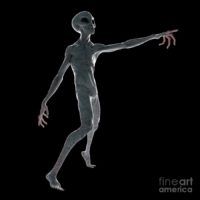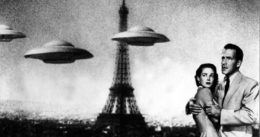Chapter 7 In Charles Lear’s Book
 While 1954 in America was mostly about the saucers, that year in France was more about the occupants, also known as “humanoids.” It was then that French researcher Aimé Michel came to international prominence as he investigated, collected data, and tried to unravel the mystery. A young Jaques Vallée first became interested in flying saucers at this time. He was later inspired by Michel’s work and went on to achieve prominence as a respected and influential figure in the field.
While 1954 in America was mostly about the saucers, that year in France was more about the occupants, also known as “humanoids.” It was then that French researcher Aimé Michel came to international prominence as he investigated, collected data, and tried to unravel the mystery. A young Jaques Vallée first became interested in flying saucers at this time. He was later inspired by Michel’s work and went on to achieve prominence as a respected and influential figure in the field.
On September 10, 1954, 34-year-old Quarouble resident Marius Dewilde reported an incident to the local police that received extensive press coverage, not only in France, but worldwide. According to Dewilde, at 10:30 p.m. he was sitting in his house, located next to some railroad tracks, when his dog, Kiki, started barking outside. Equipped with a flashlight, he went to investigate.
Outside, he noticed a large object, which he assumed was a harvest cart, six meters from his front door. He then saw two figures on a nearby path that was often used by smugglers. He pointed his flashlight at them, and there was a reflection on what seemed to be a glass helmet with a head inside. He only got a quick look, but the head seemed especially large. He estimated the figures were both about a meter in height.
At that moment, a door opened up on the side of the object. A blinding light came out, and Dewilde was paralyzed by fear. He closed his eyes, and by the time he opened them the object had risen ten meters in the air. It then shot off to the west like “lightning.” As the story made its way from newspaper to newspaper, Dewilde being paralyzed by fear turned into Dewilde being paralyzed by a beam of light.[1]
 The press was now paying attention, and many more sightings and encounters followed. The two types of craft most often reported were “soucoupes volantes” and “cigar volantes,” which translate to flying saucers and flying cigars respectively. The cigar volantes were sometimes called “Churchills” due to the constant presence of a cigar in the mouth of the famous British Prime Minister.
The press was now paying attention, and many more sightings and encounters followed. The two types of craft most often reported were “soucoupes volantes” and “cigar volantes,” which translate to flying saucers and flying cigars respectively. The cigar volantes were sometimes called “Churchills” due to the constant presence of a cigar in the mouth of the famous British Prime Minister.
In addition to the craft there were many reports of small humanoid occupants in “diving suits”, hairy dwarves, electrical and mechanical malfunctions mostly involving stalled cars, and more paralysis inducing rays of light. According to Vallée, “The ‘flying saucer’ began to lose its academic character and entered the experience of daily life. It completely monopolized the press and general conversation.”[2]
Because of all the press coverage, people started seeing saucers and little creatures everywhere. James Moseley covered some of the stories, beginning with one which he printed in its original French with no translation in the August 1954 NEXUS. In the December issue he covers several stories, including one from Perpignan involving a saucer and an occupant in a diver’s suit that rapidly re-entered his ship and took off after seeing the two dogs of the witness. This story is juxtaposed by another story in the same paragraph where the saucermen took time to pet the witness’s dog. Moseley comments: “This leaves us here at NEXUS Headquarters in a state of confusion as to whether spacemen like dogs or not. Apparently, some do and some don’t.”
The January 1955 issue includes a case written about by Moseley that almost turned deadly. M. Pierre Langlois, of the Cher Valley district, was walking home in the rain. He came upon what he perceived to be a spaceman in a luminous suit. The man seemed to be mounting a ray gun on his spaceship with the aid of a metal claw coming out of his sleeve. Langlois quickly went home, got his shotgun, came back, and fired at the creature. A few minutes later, a motorist passing by stopped and gave assistance to M. Andre Lacoste who was dressed in a white raincoat and had buckshot in his ribs and arms. The “spaceship” was a Renault, the “ray gun” was a carburetor, and the “metallic claw” was a monkey wrench.
Despite the more farcical episodes, there were cases to be taken seriously that were reported by those the French call, “digne de foi,” which in English amounts to “credible witnesses.” In Gelles, police officer M. Bachelard reported that on October 18 he was driving a police van making his rounds. At 5:30 p.m., he came upon a cigar shaped object that was approximately ten meters long and two to three meters high. His van started misfiring and he experienced feelings of semi-paralysis. He then found himself entering the village of Coheix, which was not part of his route, with no recollection of how he got there.[3]
In the midst of all the press, there was no shortage of opinions regarding the cause of all the sightings. In the October 25, 1954 edition of Time, famed psychiatrist, Carl Jung, posited that the sightings were either hallucinations brought on by cold war fears or actual alien craft. In the October 24, 1954 American Weekly, Professor Hermann Oberth was far more definite and declared, “It is my thesis that flying saucers are real and that they are space ships from another solar system.”
Many American researchers, such as Keyhoe, were not open to the humanoid reports. One group of researchers that was open to them was Civilian Saucer Intelligence, which had formed in New York that year. Some members of the group also had a relationship with Aimé Michel, having translated his book, Lueurs Sur Les Soucoupes Volantes (The Truth About Flying Saucers) into English.
Aimé Michel’s book was published in 1954 just before the onslaught of the French reports, and he found himself in the position of being that nation’s flying saucer “expert.” Out of thousands of reports, Michel investigated and collected data on nearly 300 reports that he felt were credible. While doing so, he developed a theory he called “orthoteny” based on his observation that sightings occurred along straight lines that would change daily.
To Michel, this proved the sightings were real and that there was intelligence behind the objects being seen. He noted that from September 23, to October 10, the sightings followed the pattern and that afterwards they deviated. He speculated that the objects were alien craft deployed on a methodical survey mission. The emerging randomness was due to a follow up survey with seperate areas of focus. Michel published his findings in his 1958 book, Mystérieux Objects Célestes, which CSI also translated, and it was published in America that same year as Flying Saucers and the Straight Line Mystery.
Jaques Vallée was a 19-year-old college student when he read Mystérieux Objects Célestes. He was impressed enough by the book that he wrote Michel a letter praising it. He didn’t agree with everything in the book and argued against Michel’s opinion that there was an unbridgeable evolutionary gap between ourselves and the visitors. He closed his letter telling Michel that his book “gives us a reason to face the problem. It enables us to begin valuable research quietly. Serious work can start at last because of you.”
Vallée’s passion was most likely spawned by his own sighting in 1955, along with his mother, of a disk with a bubble dome hovering above a church near his house.[4] Vallée and Michel both contributed to the 1969 book, The Humanoids, which has become a classic in UFO literature.
The 1954 sightings stuck with Vallée, and the small humanoids reported then reminded Vallée of small humanoid reports throughout human history. He set about comparing them and developed a theory that what was being seen, whether fairies, leprecauns, elves, or aliens, were all manifestations of an intelligence that coexists with us and is deceptive. He published his ideas in his 1993 book, Passport to Magonia, and was an influential contributor to the “Interdimensional Hypothesis.” Aimé Michel came to similar conclusions, but the idea that we were interacting with something unknowable bothered him enough that he abandoned his investigation in 1980. He died in 1992.
A lasting result of the 1954 flap is a law still on the books. In October of that year, Lucien Jeune, the mayor of the town of Châteauneuf-du-Pape, passed a law prohibiting flying saucers flying over, landing, or taking off in community territory. Article 2 states: “Any aircraft, known as flying saucer or flying cigar, which should land on the territory of the community will be immediately held in custody.” Article 3 places that responsibility on the forest officer and city policeman. That’s quite a responsibility for a small- town gendarme.
***
[1] Newspaper accounts retrieved from: https://ufology.patrickgross.org/1954/10sep1954quarouble.htm, January 3, 2022.
[2] Gross, Loren E. (1991). The Fifth Horseman of the Apocalypse-UFOs: A History 1954 October. Fremont, CA, p. 3
[3] ibid, pp. 65-66
[4] Kripal, Jeffrey J. Authors of the Impossible. Chicago and London: University of Chicago Press, 2011, p.150.